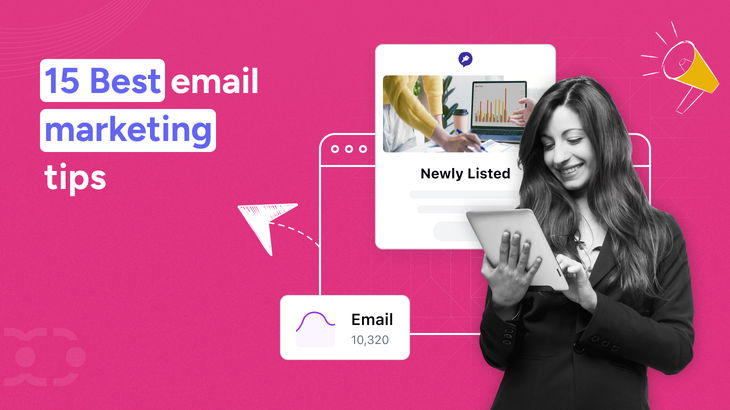1. Have clear and relevant CTAs
Optimizing your CTAs is important if your email marketing goal is to direct traffic to the landing page or capture leads.
According to WordStream, having a single CTA in your email boosts clicks by 371%.
After the email subject lines, the CTA is the second most important part of an email marketing strategy. Therefore, it needs to be clear and targeted.
The following are the key elements of writing a CTA that will get you more clicks than ever and help you create successful email marketing campaigns:
- Keep the CTA above the fold—Place your CTA in your email body so that it is visible to the user without the need to scroll further. It shouldn’t be hidden at the footer of your content, where the chances of the user missing it are quite high. Keep it on the top or at 25 – 30% of the scroll length of the email.
- Use captivating words in the CTA copy – The CTA copy is of prime importance as it will catch or lose the reader’s attention. One good practice is to use enticing words in your CTA copy that are descriptive as well as generate prompt action from the reader’s side.
- Use a fallback CTA—Sometimes, users might not want to buy from you instantly but will be interested in learning more about your offering. In scenarios where the CTA demands a high-effort step, you can compensate for it with a low-effort CTA or the fallback CTA. For instance, “Buy Now” can be supplemented with “Add it to your wishlist.”
- Have enough whitespace around the CTA – The CTA should be visible distinctly in the email copy, so you’ll need a healthy amount of whitespace around it. Don’t add too many images, colors, or text around the CTA.
2. Segment your subscribers based on preferences
Segmenting is done to serve your subscribers with targeted email newsletters and offers.
For example, if you’re an apparel website, you would not want to promote men’s apparel offers to your female customers.
List segmentation helps brands improve the probability of conversion and reduce spam emails.
By segmenting, small businesses can create personalized content for targeted groups, leading to tailored messages that enhance conversions.
According to Help Scout, email list segmentation can boost Click-Through Rates by 50%.
You can segment lists using a number of methods. The most effective ones are listed below.
- Use existing customer data—Use the customer profile data that you already have, such as gender, age, and location, to create segments in your email list.
- Use historical data—Analyze how the customer interacts with your brand regarding buying behavior, search history, and items added to the cart or wishlist.
- Ask for preferences—Use a dynamic opt-in form to capture user preferences for email newsletters and offer promos.
- Use demographic data—If the user hasn’t signed up yet, you can create segmented lists using basic demographic data such as age range, location, and affinity categories.
3. Have a crisp subject line
The subject line is the most read copy of any email newsletter, and it’s your first (and probably the last) chance to grab attention.
Like CTAs, the subject line needs special care about what words and tonality you’ll use. We have created a list of points that’ll help you improve your subject line.
Don’t use too many words – An Invesp study shows that subject lines with 6-10 words yield the most number of opens. Anything less or more than this limit will reduce the chances of a successful opening.
Preview text—Preview text appears just after the subject line and offers a preview of the email's content. If supplied correctly, it can significantly improve email open rates.
Choice of words—Some words, such as “Double your income,” “Cheap deals,” and “Cash bonus,” can put users off. However, “How-to,” “Sneak Peek,” and “You know what?” can entice interest without sounding desperate. Therefore, be careful with the words!
4. A/B test your subject lines
A/B testing refers to trying out different subject lines for the same email campaign.
It’s one of the best email marketing tips for lead generation you’ll ever employ because subject lines have a strong impact on the success of the email and client conversion.
Did you know that emails on iPhone devices only show subject lines up to 32 characters?
If your email subject line contains more than 32 characters, your overall campaign might not receive the expected response from iPhone users.
But if you created an A/B test with a shorter subject line, you’d have immediately identified how to get better responses.
Similarly, A/B testing is critical for subject lines. You should try and test several variations with your users to understand what works best.
A Campaign Monitor study found that A/B testing subject lines alongside the template and email body increased CTR by 127%.
5. Personalize your emails
Most emails that users receive are directly addressed to them with personalized messages.
About 88% of users believe that they’re more likely to respond to an email when it’s directly addressed to them.
Hence, you need to add personalization to your email marketing strategy. You can create a targeted design, messaging, and offering for your list segments.
Dynamic email templates are a great way to do this. You can use list-based placeholders in your email, wherein a single offer can be personalized for different target audiences.
More ways to personalize emails include using custom fields for the subscriber’s name, preferences, city, or company name to tell them that the email is exclusively meant for them.
By implementing a touch of personalization into your email marketing strategies, you can better connect with your subscribers.
Ready to send personalized messages?
Leverage Salesmate smart emails to run your effective email marketing campaigns.
6. Avoid the usage of “no-reply” in the sender’s email address
Ever received an email from no-reply@xyz.com? You might not initially consider it junk, but there’s growing evidence that users consider no-reply email addresses to be spam.
Moreover, no-reply email addresses were put in place for automated messages, such as the one you receive to confirm your order or send you a one-way notification that doesn’t require your response.
When you use no-reply addresses for your email marketing campaigns, you end up confusing your email subscribers and potentially harming your sender reputation.
Instead, you can use friendlier email addresses, such as marketing@yourorg.com or sales.repname@yourorg.com, which are easier for your target audience to understand.
7. Understand the process of email rendering
All emails are built up of HTML, CSS, and JS code, which the email client converts into user-friendly templates.
This is important to understand because a favorable email experience demands a standard HTML structure.
When you test your emails, you must check if they look the same on varying screen sizes. Your email may look perfect on a desktop computer but might mess up on a smartphone screen.
To ensure readability for all recipients, it's also crucial to maintain a clean and optimized plain text version of your emails.
To avoid this, you must use an email template editor tool that creates responsive emails.
The structure, colors, and alignment of elements must all be re-adjusted according to the screen size.
You can tinker with the HTML code yourself, but be careful of testing your template multiple times. Putsmail is a software tool designed to test email templates before sending them.
8. Include your company logo
Users always want to know who is sending them marketing emails. If the sender is wildly unknown or the email looks unprofessional, users won’t bother opening it.
Hence, you should always add elements of trust to your email, of which your company logo is of the utmost importance.
It reflects that you’re a legitimate brand and that your offer can be trusted.
In addition to the company logo, you can always include a personal sender name and company-specific formatting and directly address the recipient with their name.
These small but significant customizations go a long way in ensuring that your emails are taken seriously.
9. Always automate your emails and follow-ups
It’s hard to check how many people are engaged with your marketing emails and then take action manually.
If your list contains thousands of addresses, measuring your email marketing performance is impractical.
Automating your email marketing process using email marketing CRM is a smarter way to handle all incoming responses.
You can set up automatic triggers whenever the user takes a certain action.
Utilizing user behavior, such as browsing products or adding items to a cart, can optimize engagement and increase conversion rates through timely and relevant communication.
This improves your overall email marketing performance by treating every response selectively. Some common examples of email automation are as follows;
- Welcome emails
- Onboarding emails
- Retargeting emails
- Abandoned Cart emails
- Follow-up emails
You can create an automation flow to manage leads and responses accurately.
The following is an example of managing a contact using a smart email automation flow with triggers and actions for each step of the process.
10. Create a sense of urgency
Using and creating a sense of time sensitivity in your email marketing promotions effectively increases your audience's response rate.
Recipients are more likely to stay active when they know they might miss a chance to gain something of value.
The beauty of the countdown effect is the effective use of countdown timers; using short-term offers and phrases like ‘Just 2 days left’ or ‘Limited stocks’ triggers the fundamental psychological factor called FOMO (Fear of Missing Out).
Here is a checklist that can help bring sensations and urgency:
- Add a countdown timer for sales, webinars, or product launches.
- Ensure the timer complements the overall email design without being overwhelming.
- Combine the timer with action-driven CTAs like “Claim Now” or “Last Chance.”
- Use dynamic timers that update based on the recipient’s time zone.
11. Make use of AMP (Accelerated mobile pages)
AMP for email changes how people engage with content within their inboxes and makes it far more active.
Standard emails typically require the user to go to an external website or application for the desired action.
AMP for email eliminates this hindrance to end-user interactions by extending certain functionality and interaction capabilities within the body of the mail, including the capacity to RSVP lessons, give feedback, or even make transactions.
- Allow recipients to RSVP to events or book appointments from the email itself.
- Embed forms, such as surveys or feedback forms, directly in emails.
- Use AMP to create engaging, real-time content updates like stock levels or live scores.
- Include dynamic product carousels or personalized content.
12. Leverage gamification model
Gamification transforms your emails from static content into interactive, engaging experiences that captivate your audience.
By incorporating game-like elements, you invite subscribers to interact with your brand in a fun and rewarding way, encouraging deeper engagement and fostering loyalty.
Instead of simply presenting information, gamified emails make your campaigns more dynamic, memorable, and enjoyable for recipients.
- Use spin-the-wheel graphics for discounts or free products.
- Include scratch cards for exclusive offers.
- Create scavenger hunts with links to hidden prizes or content on your website.
- Add quizzes or polls where users can win discounts or rewards.
13. Optimize for dark mode
As more individuals utilize their devices' dark mode feature, it is crucial to create emails that look good in both light and dark modes. Failing to do so will result in ill-formatted emails, and the click-through rate will reduce significantly.
- Avoid using images with transparent backgrounds.
- Test font colors to ensure they contrast nicely in both modes.
- Use dark-mode-compatible email templates to maintain design consistency.
- Test emails across various devices and email clients to ensure compatibility.
14. Incorporate storytelling methodology
Interactive storytelling enhances email marketing by adding value, fun, and excitement to your possibly informative campaigns.
This approach will make the viewers part of the story and maintain deeper connections with the advertised brand.
By blending creativity with interaction, it is possible to transform even the most superficial communication in an email into a stunning experience that would leap out of today’s crowded inboxes.
- Create choose-your-own-adventure-style emails with clickable paths.
- Include embedded videos or animations that tell a story.
- Develop interactive infographics that highlight your product’s benefits.
- Use scrolling effects or revealable content for added intrigue.
15. Always test your email
The last part is one of the most overlooked yet successful email marketing tips – testing your email marketing campaigns.
As we highlighted earlier, emails must be reviewed and checked for errors before launching the campaign.
Testing also prevents you from killing your own campaign due to a poorly created template or underutilized resources.
Here’s a quick checklist for testing your emails:
- Test emails on multiple screens – especially on mobile devices.
- Check for image load times and avoid heavy images in your emails.
- Check if the CTA hyperlink is correctly redirecting.
- Check if the email is landing correctly or going to the spam or promotions folder.
- Check the segment or subscriber list you’re sending.
- Shoot out a few test emails to make sure everything is right.
Why is email marketing important?
Email marketing then remains one of the most effective categories of digital marketing for any business.
For a small business, a nonprofit organization, or any eCommerce business, nothing comes close to the potential of email marketing to reach customers and sell your products.
1. Direct engagement with customers
Emails have the benefit of offering direct contact with your audience.
They reach the customer directly in their mail inbox, which they are sure to glance at every day.
Emails help businesses sustain their relationships with customers by providing more personalized communication, information sharing, and touches, including tips for relevant email marketing campaign or updates on products.
2. Cost effective and high ROI
Email marketing is incredibly cost-effective compared to other marketing channels. With minimal investment, businesses can achieve a high return on investment (ROI).
According to research, the average ROI for email marketing is $42 for every $1 spent.
Email marketing is ideal for small businesses and beginners looking to grow their customer base without breaking the bank.
3. Helps in lead generation and nurturing
Regarding lead generation, email marketing cannot be underscored for any business.
This also allows you to follow up on the leads through specific campaigns like welcome emails, onboarding emails, or follow-up emails.
You can easily turn prospects into loyal customers by using email marketing content tips and CRM tools like Salesmate.
4. Measurable results and insights
One of the best email marketing tips and tricks is to track and analyze performance metrics such as open rates, click-through rates, and conversions.
These insights help you refine your strategy and achieve better results over time.
Conclusion
Email marketing is more than just sending messages—it's about building lasting relationships with your audience.
Success lies in understanding your subscribers, crafting emails that speak directly to their needs, and consistently optimizing for better engagement.
The key is not to expect perfection immediately but to embrace the process of testing, learning, and evolving.
Each campaign is an opportunity to connect deeper, learn more, and refine your strategy.
With Salesmate CRM, you gain the tools to make this process smoother and more effective, ensuring that your email marketing tips are put to their best use.
Whether you automate your follow-ups, personalize each email to build stronger customer connections, or use real-time analytics to fine-tune your approach, Salesmate gives you the insights and power to take your email marketing to new heights.
Ready to create meaningful, conversion-driven campaigns that truly resonate? Let Salesmate be the catalyst for your email marketing success.
Start today, and let’s grow together!
Frequently asked questions
1. What are the successful email marketing tips for successful campaigns?
When designing an effective email marketing strategy, you must follow certain essentials. These include subject lines, audience segmentation, personalization, a Call To Action (CTA), and testing your emails for responsiveness and bugs.
2. How can small businesses optimize their email marketing strategies?
Small businesses can successfully utilize email marketing through list segmentation, automated follow-ups, personalization, and the inexpensive yet efficient CRM tool Salesmate.
3. What are the best practices for email marketing copywriting?
Effective email marketing copywriting involves using concise, compelling language, addressing the reader's needs, incorporating a clear CTA, and avoiding spammy words. Tailoring content to your audience’s preferences also boosts engagement.
4. How can B2B companies improve their email marketing strategies?
B2B companies should prioritize personalization, use data-driven segmentation, create value-driven content, and leverage automation tools to streamline follow-ups. Regular A/B testing of campaigns is also crucial for optimizing performance.
5. What are effective email marketing tips for eCommerce businesses?
eCommerce businesses can boost email marketing by sending abandoned cart reminders, offering personalized product recommendations, creating urgency with limited-time offers, and using dynamic content to enhance user engagement.







Key Takeaways
On average, a person receives 121 emails daily, making it increasingly challenging for your message to stand out and open.
With the surge in email users and countless brands sending promotional messages, email marketing has become more crowded than ever.
Relying on generic and overly used email marketing tips and techniques will no longer be enough to stand out and reach your goals.
It's time to elevate your email marketing strategy to cut through the noise.
At this point, you might be questioning whether email marketing is still worth the effort. The answer is a resounding yes!
Email marketing delivers impressive ROI for those who stay ahead of the curve. However, this success is reserved for marketers in tune with the latest trends and best practices.
To help you stay competitive, we’ve compiled a list of effective email marketing tips and tricks to give your campaigns the edge in 2025.
Whether you're familiar with some of these tips or not, revisiting the evolving landscape of email marketing will help you better position your campaigns for success.
Email marketing tips and best practices
Email marketing remains one of the most powerful tools in any marketer’s toolkit. It offers a direct line to your audience, providing a unique opportunity to engage, inform, and drive conversions.
Focusing on best practices that resonate with your audience ensures your email marketing campaign tips deliver the best possible outcomes.
By continuously improving your approach, you can foster stronger customer relationships, increase open rates, and boost ROI.
Below, we’ve compiled a list of top 15 email marketing tips and tricks that you can implement right away.
1. Have clear and relevant CTAs
Optimizing your CTAs is important if your email marketing goal is to direct traffic to the landing page or capture leads.
According to WordStream, having a single CTA in your email boosts clicks by 371%.
After the email subject lines, the CTA is the second most important part of an email marketing strategy. Therefore, it needs to be clear and targeted.
The following are the key elements of writing a CTA that will get you more clicks than ever and help you create successful email marketing campaigns:
2. Segment your subscribers based on preferences
Segmenting is done to serve your subscribers with targeted email newsletters and offers.
For example, if you’re an apparel website, you would not want to promote men’s apparel offers to your female customers.
List segmentation helps brands improve the probability of conversion and reduce spam emails.
By segmenting, small businesses can create personalized content for targeted groups, leading to tailored messages that enhance conversions.
According to Help Scout, email list segmentation can boost Click-Through Rates by 50%.
You can segment lists using a number of methods. The most effective ones are listed below.
3. Have a crisp subject line
The subject line is the most read copy of any email newsletter, and it’s your first (and probably the last) chance to grab attention.
Like CTAs, the subject line needs special care about what words and tonality you’ll use. We have created a list of points that’ll help you improve your subject line.
Don’t use too many words – An Invesp study shows that subject lines with 6-10 words yield the most number of opens. Anything less or more than this limit will reduce the chances of a successful opening.
Preview text—Preview text appears just after the subject line and offers a preview of the email's content. If supplied correctly, it can significantly improve email open rates.
Choice of words—Some words, such as “Double your income,” “Cheap deals,” and “Cash bonus,” can put users off. However, “How-to,” “Sneak Peek,” and “You know what?” can entice interest without sounding desperate. Therefore, be careful with the words!
4. A/B test your subject lines
A/B testing refers to trying out different subject lines for the same email campaign.
It’s one of the best email marketing tips for lead generation you’ll ever employ because subject lines have a strong impact on the success of the email and client conversion.
Did you know that emails on iPhone devices only show subject lines up to 32 characters?
If your email subject line contains more than 32 characters, your overall campaign might not receive the expected response from iPhone users.
But if you created an A/B test with a shorter subject line, you’d have immediately identified how to get better responses.
Similarly, A/B testing is critical for subject lines. You should try and test several variations with your users to understand what works best.
A Campaign Monitor study found that A/B testing subject lines alongside the template and email body increased CTR by 127%.
5. Personalize your emails
Most emails that users receive are directly addressed to them with personalized messages.
About 88% of users believe that they’re more likely to respond to an email when it’s directly addressed to them.
Hence, you need to add personalization to your email marketing strategy. You can create a targeted design, messaging, and offering for your list segments.
Dynamic email templates are a great way to do this. You can use list-based placeholders in your email, wherein a single offer can be personalized for different target audiences.
More ways to personalize emails include using custom fields for the subscriber’s name, preferences, city, or company name to tell them that the email is exclusively meant for them.
By implementing a touch of personalization into your email marketing strategies, you can better connect with your subscribers.
Ready to send personalized messages?
Leverage Salesmate smart emails to run your effective email marketing campaigns.
6. Avoid the usage of “no-reply” in the sender’s email address
Ever received an email from no-reply@xyz.com? You might not initially consider it junk, but there’s growing evidence that users consider no-reply email addresses to be spam.
Moreover, no-reply email addresses were put in place for automated messages, such as the one you receive to confirm your order or send you a one-way notification that doesn’t require your response.
When you use no-reply addresses for your email marketing campaigns, you end up confusing your email subscribers and potentially harming your sender reputation.
Instead, you can use friendlier email addresses, such as marketing@yourorg.com or sales.repname@yourorg.com, which are easier for your target audience to understand.
7. Understand the process of email rendering
All emails are built up of HTML, CSS, and JS code, which the email client converts into user-friendly templates.
This is important to understand because a favorable email experience demands a standard HTML structure.
When you test your emails, you must check if they look the same on varying screen sizes. Your email may look perfect on a desktop computer but might mess up on a smartphone screen.
To ensure readability for all recipients, it's also crucial to maintain a clean and optimized plain text version of your emails.
To avoid this, you must use an email template editor tool that creates responsive emails.
The structure, colors, and alignment of elements must all be re-adjusted according to the screen size.
You can tinker with the HTML code yourself, but be careful of testing your template multiple times. Putsmail is a software tool designed to test email templates before sending them.
8. Include your company logo
Users always want to know who is sending them marketing emails. If the sender is wildly unknown or the email looks unprofessional, users won’t bother opening it.
Hence, you should always add elements of trust to your email, of which your company logo is of the utmost importance.
It reflects that you’re a legitimate brand and that your offer can be trusted.
In addition to the company logo, you can always include a personal sender name and company-specific formatting and directly address the recipient with their name.
These small but significant customizations go a long way in ensuring that your emails are taken seriously.
9. Always automate your emails and follow-ups
It’s hard to check how many people are engaged with your marketing emails and then take action manually.
If your list contains thousands of addresses, measuring your email marketing performance is impractical.
Automating your email marketing process using email marketing CRM is a smarter way to handle all incoming responses.
You can set up automatic triggers whenever the user takes a certain action.
Utilizing user behavior, such as browsing products or adding items to a cart, can optimize engagement and increase conversion rates through timely and relevant communication.
This improves your overall email marketing performance by treating every response selectively. Some common examples of email automation are as follows;
You can create an automation flow to manage leads and responses accurately.
The following is an example of managing a contact using a smart email automation flow with triggers and actions for each step of the process.
10. Create a sense of urgency
Using and creating a sense of time sensitivity in your email marketing promotions effectively increases your audience's response rate.
Recipients are more likely to stay active when they know they might miss a chance to gain something of value.
The beauty of the countdown effect is the effective use of countdown timers; using short-term offers and phrases like ‘Just 2 days left’ or ‘Limited stocks’ triggers the fundamental psychological factor called FOMO (Fear of Missing Out).
Here is a checklist that can help bring sensations and urgency:
11. Make use of AMP (Accelerated mobile pages)
AMP for email changes how people engage with content within their inboxes and makes it far more active.
Standard emails typically require the user to go to an external website or application for the desired action.
AMP for email eliminates this hindrance to end-user interactions by extending certain functionality and interaction capabilities within the body of the mail, including the capacity to RSVP lessons, give feedback, or even make transactions.
12. Leverage gamification model
Gamification transforms your emails from static content into interactive, engaging experiences that captivate your audience.
By incorporating game-like elements, you invite subscribers to interact with your brand in a fun and rewarding way, encouraging deeper engagement and fostering loyalty.
Instead of simply presenting information, gamified emails make your campaigns more dynamic, memorable, and enjoyable for recipients.
13. Optimize for dark mode
As more individuals utilize their devices' dark mode feature, it is crucial to create emails that look good in both light and dark modes. Failing to do so will result in ill-formatted emails, and the click-through rate will reduce significantly.
14. Incorporate storytelling methodology
Interactive storytelling enhances email marketing by adding value, fun, and excitement to your possibly informative campaigns.
This approach will make the viewers part of the story and maintain deeper connections with the advertised brand.
By blending creativity with interaction, it is possible to transform even the most superficial communication in an email into a stunning experience that would leap out of today’s crowded inboxes.
15. Always test your email
The last part is one of the most overlooked yet successful email marketing tips – testing your email marketing campaigns.
As we highlighted earlier, emails must be reviewed and checked for errors before launching the campaign.
Testing also prevents you from killing your own campaign due to a poorly created template or underutilized resources.
Here’s a quick checklist for testing your emails:
Why is email marketing important?
Email marketing then remains one of the most effective categories of digital marketing for any business.
For a small business, a nonprofit organization, or any eCommerce business, nothing comes close to the potential of email marketing to reach customers and sell your products.
1. Direct engagement with customers
Emails have the benefit of offering direct contact with your audience.
They reach the customer directly in their mail inbox, which they are sure to glance at every day.
Emails help businesses sustain their relationships with customers by providing more personalized communication, information sharing, and touches, including tips for relevant email marketing campaign or updates on products.
2. Cost effective and high ROI
Email marketing is incredibly cost-effective compared to other marketing channels. With minimal investment, businesses can achieve a high return on investment (ROI).
According to research, the average ROI for email marketing is $42 for every $1 spent.
Email marketing is ideal for small businesses and beginners looking to grow their customer base without breaking the bank.
3. Helps in lead generation and nurturing
Regarding lead generation, email marketing cannot be underscored for any business.
This also allows you to follow up on the leads through specific campaigns like welcome emails, onboarding emails, or follow-up emails.
You can easily turn prospects into loyal customers by using email marketing content tips and CRM tools like Salesmate.
4. Measurable results and insights
One of the best email marketing tips and tricks is to track and analyze performance metrics such as open rates, click-through rates, and conversions.
These insights help you refine your strategy and achieve better results over time.
Conclusion
Email marketing is more than just sending messages—it's about building lasting relationships with your audience.
Success lies in understanding your subscribers, crafting emails that speak directly to their needs, and consistently optimizing for better engagement.
The key is not to expect perfection immediately but to embrace the process of testing, learning, and evolving.
Each campaign is an opportunity to connect deeper, learn more, and refine your strategy.
With Salesmate CRM, you gain the tools to make this process smoother and more effective, ensuring that your email marketing tips are put to their best use.
Whether you automate your follow-ups, personalize each email to build stronger customer connections, or use real-time analytics to fine-tune your approach, Salesmate gives you the insights and power to take your email marketing to new heights.
Ready to create meaningful, conversion-driven campaigns that truly resonate? Let Salesmate be the catalyst for your email marketing success.
Start today, and let’s grow together!
Frequently asked questions
1. What are the successful email marketing tips for successful campaigns?
When designing an effective email marketing strategy, you must follow certain essentials. These include subject lines, audience segmentation, personalization, a Call To Action (CTA), and testing your emails for responsiveness and bugs.
2. How can small businesses optimize their email marketing strategies?
Small businesses can successfully utilize email marketing through list segmentation, automated follow-ups, personalization, and the inexpensive yet efficient CRM tool Salesmate.
3. What are the best practices for email marketing copywriting?
Effective email marketing copywriting involves using concise, compelling language, addressing the reader's needs, incorporating a clear CTA, and avoiding spammy words. Tailoring content to your audience’s preferences also boosts engagement.
4. How can B2B companies improve their email marketing strategies?
B2B companies should prioritize personalization, use data-driven segmentation, create value-driven content, and leverage automation tools to streamline follow-ups. Regular A/B testing of campaigns is also crucial for optimizing performance.
5. What are effective email marketing tips for eCommerce businesses?
eCommerce businesses can boost email marketing by sending abandoned cart reminders, offering personalized product recommendations, creating urgency with limited-time offers, and using dynamic content to enhance user engagement.
Yasir Ahmad
Content EditorYasir Ahmad is the content editor at Salesmate who adds the finishing touch to the blogs you enjoy, turning CRM talk into stories you’ll actually want to read. He’s all about making complex stuff simple and a little fun too. When he’s not fine-tuning words, you can find him diving into the world of literature, always on the hunt for the next great story.